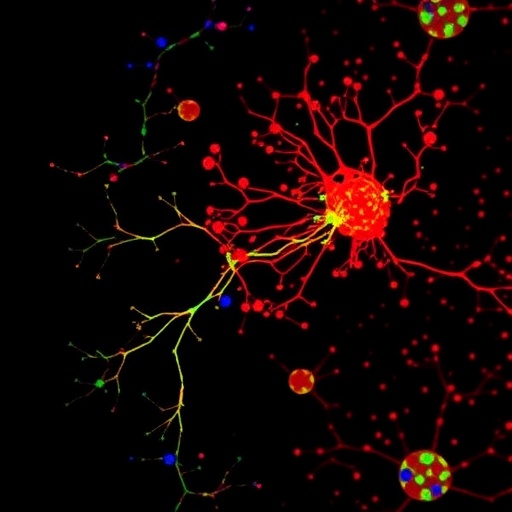
Researchers at the University of Gothenburg have uncovered a groundbreaking mechanism by which the influenza A virus commandeers the host’s gene regulatory machinery to enhance its own replication and dissemination. Their findings, recently published in the prestigious journal Nucleic Acids Research, reveal that the virus exploits a pivotal cellular protein involved in RNA interference (RNAi) to suppress the host’s immune responses, exposing a novel vulnerability in the viral life cycle that could be therapeutically targeted.
At the heart of this discovery is the protein Argonaute 2 (AGO2), a key effector in the RNAi pathway that normally modulates gene expression post-transcriptionally in the cytoplasm. Intriguingly, the influenza virus manipulates AGO2 to relocate into the cell nucleus—a location where this protein rarely operates under normal physiological conditions. This nuclear relocalization enables the virus to strategically silence genes essential for the activation of type I interferons, molecules critical for initiating antiviral defense signals in neighboring uninfected cells.
Type I interferons act as alarm substances, orchestrating the immune system’s preparedness to viral invasion by enhancing the antiviral state of cells. By dampening the expression of interferon-related genes through AGO2’s aberrant activity within the nucleus, the influenza virus effectively muffles these alarm signals, blunting the host’s immune alert system and facilitating unchecked viral replication. This finding unveils a previously unanticipated nuclear function of AGO2 exploited by the virus, challenging traditional views of RNAi localization and immune modulation.
Key experiments demonstrated that AGO2 is ferried into the nucleus alongside the tumor suppressor protein p53, which is well-known for its role in DNA damage responses and transcriptional regulation. Once inside the nucleus, AGO2 associates directly with chromatin regions that regulate interferon gene expression, functioning as a repressive factor. This interaction effectively turns off critical immune genes, thereby sabotaging the cellular defense mechanisms at a genetic level.
The implications of this study extend beyond virology into the broader understanding of RNAi dynamics, as it reveals that RNAi effectors like AGO2 can be co-opted to influence nuclear gene transcription under pathological stress. The influenza A virus ingeniously manipulates this dual role of AGO2 to subvert host immunity, highlighting the sophistication of viral-host interactions evolved over millennia.
Prompted by these insights, the team investigated whether disrupting the virus’s ability to commandeer AGO2 would restore immune function and inhibit viral propagation. Encouragingly, the researchers employed arsenic trioxide (ATO), a drug already in clinical use for acute promyelocytic leukemia, hypothesizing that it could interfere with AGO2’s nuclear functions. Treatment with ATO in both cultured cells and infected mice resulted in a marked increase in type I interferon production and a concomitant decrease in viral load within the lungs, underscoring the therapeutic potential of targeting host pathways rather than viral components alone.
This approach signifies a paradigm shift in antiviral strategies, focusing on reinforcing endogenous cellular defenses instead of directly attacking the virus—a tactic that could circumvent common issues of antiviral resistance. By modulating RNAi machinery, specifically AGO2’s nuclear activity, it may be possible to develop broad-spectrum antivirals effective not only against influenza but potentially other RNA viruses with similar immune evasion strategies.
One of the senior authors, Aishe Sarshad, an associate professor of cellular and molecular biology at the University of Gothenburg’s Sahlgrenska Academy, emphasized the novelty of these findings: “It was astonishing to observe how influenza virus hijacks such a fundamental and finely tuned system as RNA interference—especially within the nucleus where AGO2’s regulatory roles have been largely uncharted until now.”
Beyond the molecular discoveries, the study expands the landscape of immunological research by demonstrating a novel viral mechanism that suppresses innate immune signaling pathways at the transcriptional level. This adds a critical piece to the puzzle of how influenza A evades immune detection and persists within the host environment, contributing to its global burden of seasonal epidemics and pandemics.
The collaborative work, much of which was conducted by postdoctoral researcher Hsiang-Chi Huang, delineates the detailed molecular interplay between AGO2, p53, and interferon-related genes, revealing a complex network exploited by viral infection. This intricate interplay not only suppresses antiviral responses but may also influence viral pathogenicity and disease severity.
Looking forward, the research team intends to explore whether similar nuclear hijacking of AGO2 or related RNAi components occurs in infections by other RNA viruses, which could open avenues for a universal antiviral therapy approach. The possibility of manipulating the host’s own RNAi mechanisms to augment immunity against diverse viral pathogens underscores the significance of this discovery.
In conclusion, this study pioneers a novel understanding of influenza A virus-host interactions, identifying nuclear AGO2 as a critical player in viral immune evasion and demonstrating the therapeutic promise of arsenic trioxide in restoring immune function. These findings could revolutionize antiviral treatment paradigms, shifting the focus toward modulation of host gene regulatory systems in the battle against viral diseases.
Subject of Research: Animals
Article Title: Nuclear AGO 2 Supports Influenza A Virus Replication through type-I interferon regulation
News Publication Date: 12-Apr-2025
Web References: http://dx.doi.org/10.1093/nar/gkaf268
Image Credits: Photo: Johan Wingborg (Aishe Sarshad and Davide Angeletti, Sahlgrenska Academy at the University of Gothenburg)
Keywords: Influenza A virus, AGO2, RNA interference, type I interferons, immune evasion, arsenic trioxide, antiviral therapy, nuclear gene regulation, p53, RNA viruses, host-pathogen interaction
Tags: antiviral defense mechanismsArgonaute 2 protein functioncellular machinery hijackinggene regulatory mechanismshost-pathogen interactionsimmune system evasion strategiesinfluenza A virus replicationnovel therapeutic targets for influenzaRNA interference and influenzatype I interferons roleUniversity of Gothenburg research findingsviral life cycle vulnerabilities





